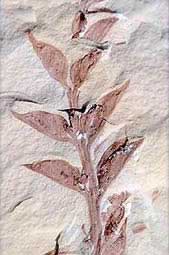Fresh bunch of old flowers

The pick of the new group of flowering plants. <br>© Science <br>
Fossil plants form new branch in flower family tree.
Fossils recently plucked from rocks in China are the first representatives of a hitherto unknown group of flowering plants, say their discoverers Ge Sun of Jilin University and colleagues1.
They also add to growing evidence that flowering plants, which now dominate the land, originally emerged from the water.
The researchers call the group Archaefructaceae. Its members probably flourished in lakes and ponds about 125 million years ago while dinosaurs walked the Earth. They appear to have grown like waterlilies and looked like a cross between ferns and seaweed, having no petals or sepals.
The group is more closely related to the flowering plants, or angiosperms, than to the palm-like cycads, ginkgo and other ancient flora also alive at the time. But the Archaefructaceae are no missing link in plant evolution. Rather, they are an evolutionary dead end – the plants have no known descendants.
The fossils are of two species; Sun’s team names them Archaefructus sinensis and Archaefructus lianogensis. They are exquisitely preserved, giving a detailed picture of Archaefructus’ life history.
The feathery leaves are on long stalks, which are shorter towards the top of the plants’ stems. The stems seem too thin to have stood upright, suggesting that Archaefructus was aquatic, and swellings at the base of the leaves may have given the plants added buoyancy.
The flowers probably developed above the water, as their pollen seems best suited to wind or insect dispersal: the pollen-producing anthers reached maturity before the females carpels to avoid self fertilization.
References
- Sun, G. et al. Archaefructaceae, a new basal angiosperm family. Science, 296, 899 – 904, (2002).
Media Contact
All latest news from the category: Life Sciences and Chemistry
Articles and reports from the Life Sciences and chemistry area deal with applied and basic research into modern biology, chemistry and human medicine.
Valuable information can be found on a range of life sciences fields including bacteriology, biochemistry, bionics, bioinformatics, biophysics, biotechnology, genetics, geobotany, human biology, marine biology, microbiology, molecular biology, cellular biology, zoology, bioinorganic chemistry, microchemistry and environmental chemistry.
Newest articles

Combatting disruptive ‘noise’ in quantum communication
In a significant milestone for quantum communication technology, an experiment has demonstrated how networks can be leveraged to combat disruptive ‘noise’ in quantum communications. The international effort led by researchers…

Stretchable quantum dot display
Intrinsically stretchable quantum dot-based light-emitting diodes achieved record-breaking performance. A team of South Korean scientists led by Professor KIM Dae-Hyeong of the Center for Nanoparticle Research within the Institute for…

Internet can achieve quantum speed with light saved as sound
Researchers at the University of Copenhagen’s Niels Bohr Institute have developed a new way to create quantum memory: A small drum can store data sent with light in its sonic…





















